Disclosure: Meeple Mountain received a free copy of this product in exchange for an honest, unbiased review. This review is not intended to be an endorsement.
You’ve probably heard of Steven Aramini. Part of the team that created Circle the Wagons and Sprawlopolis, Aramini has also found individual success with titles like Barker’s Row and Animal Kingdoms. 2022 promises to be another big year for Aramini with a host of upcoming releases: River Wild, Ancient Realms, and Naturopolis (the third installment in the Sprawlopolis line, after Agropolis). Apparently not content with that, Aramini is also launching a new publishing venture under the banner of Write Stuff Games. Aramini’s inaugural game for Write Stuff is Fliptown, a rootin’ tootin’ random-and-write that promises Old West charm with modern sensibilities.
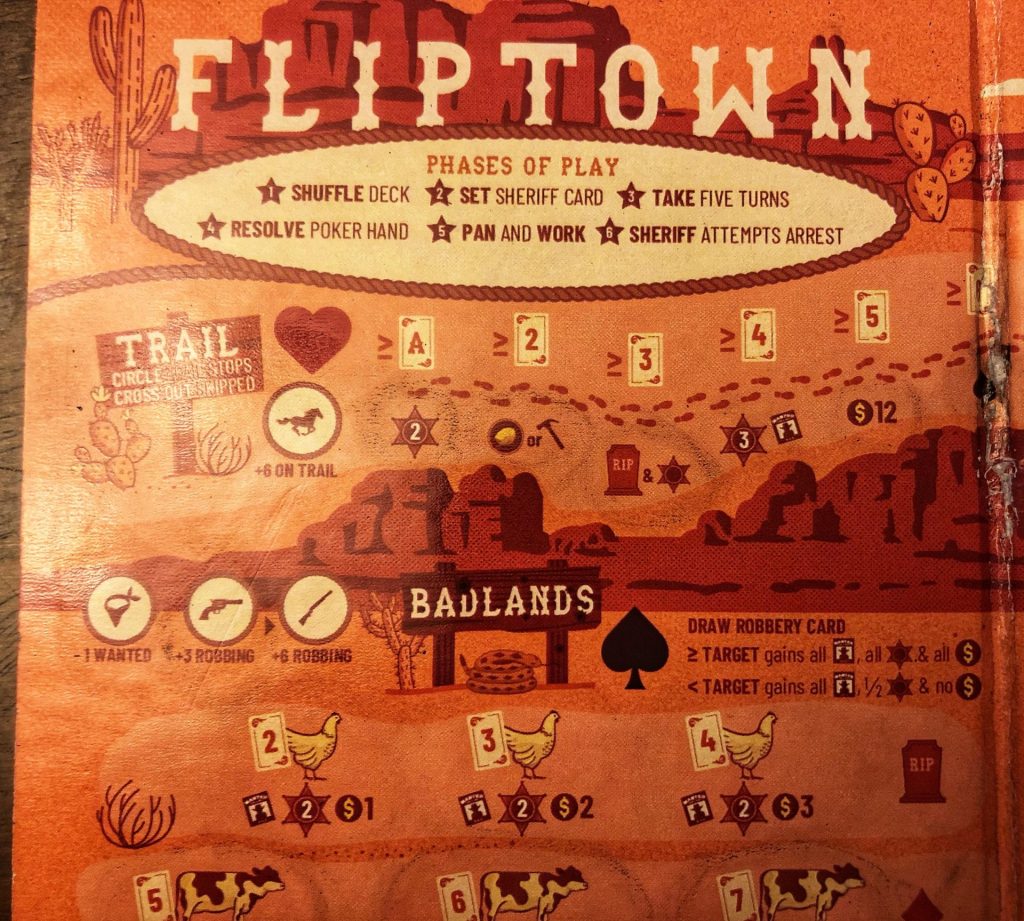
Ante Up
The goal of Fliptown is to rack up the most red stars (i.e., victory points). These stars are earned (and lost!) directly during play, though some long-term investments yield silver stars which aren’t tallied until the end of the game. Players will also score a few extra stars for leftover cash and gold, the two economic resources that help pay costs.
Each of the game’s three rounds features five turns plus a few extra bookkeeping steps. A turn consists of revealing three new cards, planning out how to use them, and taking one or more actions based on that choice.
If that sounds overwhelmingly vague, it’s because there’s a LOT to do in Fliptown. You might spend your time robbing stagecoaches, jumping claims down in the mine, riding your horse down the dusty trail, laying low in town to hide from the local sheriff, or all of the above. Whatever the Wild West means to you, there’s a good chance it’s reflected in this game.
Let’s start with the cards: each turn you’ll take your three cards and select one for its suit ONLY, one for its value ONLY, and one to add to your poker hand (which scores at the end of each round based on conventional poker rankings). Your action for the turn is determined by the combination of the suit card’s suit and the value card’s value. Four sections of the board—the Trail, Badlands, Mine, and Town—match the four suits, with specific choices for each value. For example, if you take a Spade for your suit, you’ll visit the Badlands to attempt a robbery. Choose a 2, 3, or 4 for your value and you’ll be grabbing a chicken from a nearby farm; pick a Jack, Queen, or King and you’ll be going after a train instead.
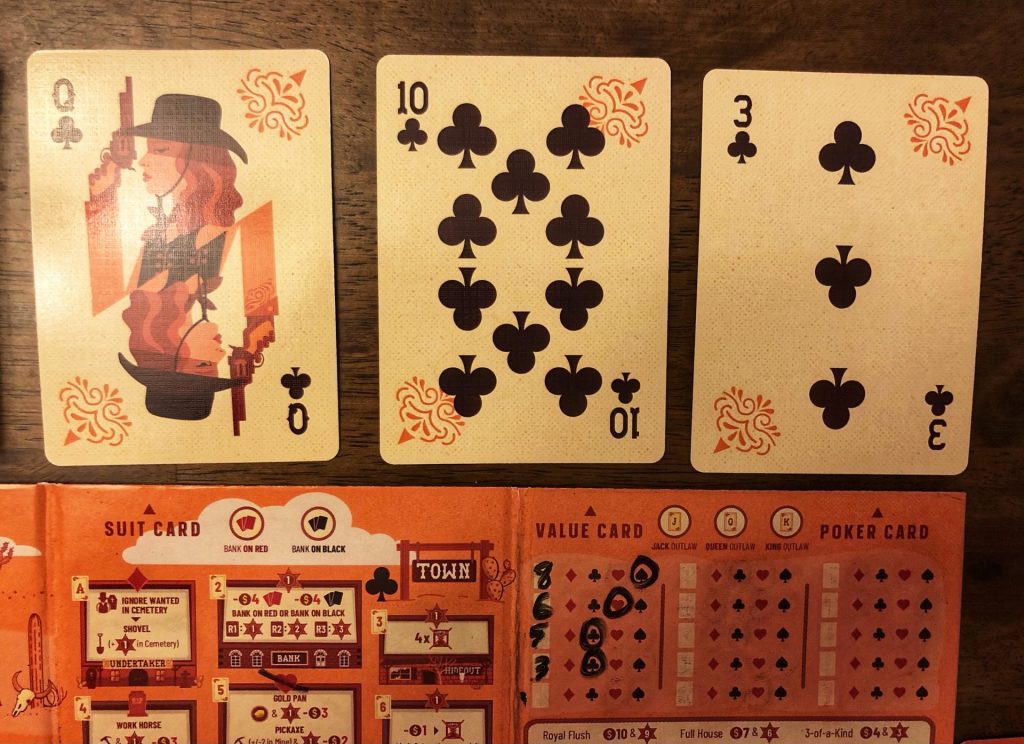
As with many random-and-write games, each section on the Fliptown board has its own rules, creating a mesh of decisions about which suit and value to select. In most cases, each specific spot can only be chosen once. The Trail is a linear path with each successive step offering greater rewards; as you visit, you can choose to go as far as your value card, but any skipped steps are lost forever. As mentioned, the Badlands is where robberies happen; robberies are resolved by flipping a card to determine whether it’s a higher or lower value than the selected target. The Mine is a kind of pyramid, where you start at the top and work your way down through various reward-filled chambers. The Town offers a host of different unique possibilities in the form of various buildings, many with multiple sub-options or increased utility on subsequent trips.
Raising the Stakes
It’s worth drilling in on the Town because it’s where most of the game’s systems mingle. Each of the buildings offer something to help you in your nefarious career. For example, you might visit the General Store where you can spend cash to pick up either a gold pan or a pickaxe, upgrades which will earn you free gold and money (respectively) at the end of the round. You might instead buy the useful bandana, which reduces the amount of Wanted you gain when attempting robberies in the Badlands.
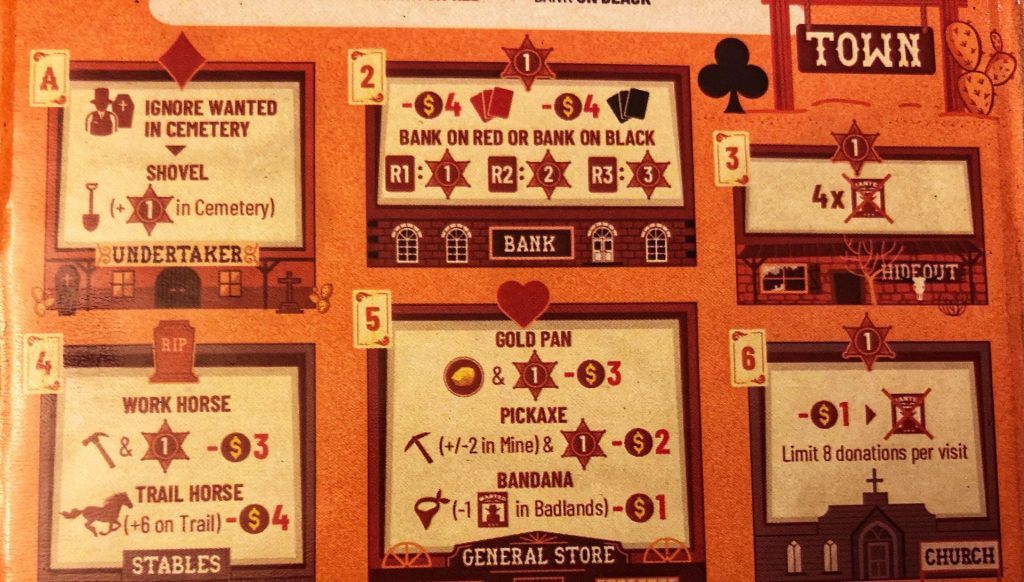
Wanted is a measurement of your notoriety and is usually increased by taking the more profitable actions like robbing trains. Wanted won’t have any impact on your turns, but unless you’ve been playing cautiously, you’ll need to reckon with the Sheriff at the end of the round. Maybe you’ll bribe the Sheriff by spending gold equal to your Wanted level, or maybe you’ll take your chances on revealing the hidden Sheriff card. If the Sheriff card is higher than your Wanted level, you’ll have to spend your precious cash or your even more precious stars on bail. There’s no good way around the law.
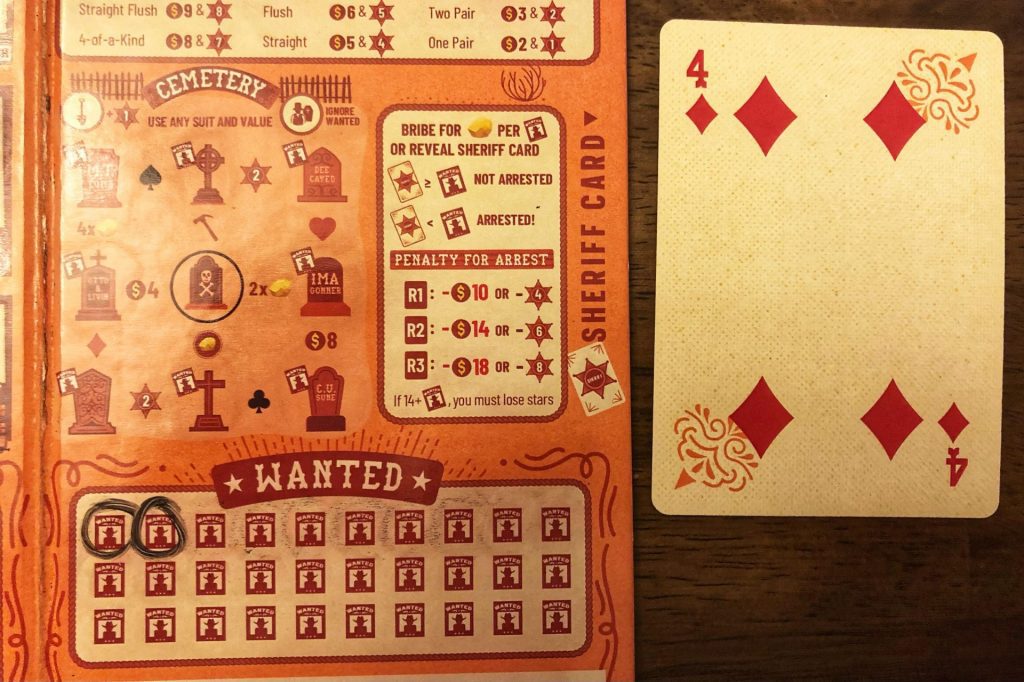
Other Town buildings provide ways to reduce your Wanted level, convert resources to stars, or purchase upgrades that make you better. There are even a few ways to gamble or invest in your future, like the Bail Bonds office where you can score a nice reward whenever you see a Jack, Queen, or King card in your 3-card lineup. While most areas on the board can only be visited once, most of the Town buildings can be visited multiple times, giving you more opportunities to tailor your playstyle at the cost of making progress elsewhere.
Town buildings also tend to come with bonus actions, available only on the first visit. These are one-off actions of a specific type (a Mine action, for example) that generally act as though you had a value card of your choice. They’re powerful, so hitching onto them when you can is a good thing. They’re also available in other parts of the board, though usually this involves a lot more effort.
Chasing the Draw
If you don’t like the options afforded by your cards, you can spend gold to either switch a card’s suit or adjust its value. (Note that this ability can only be used on the suit and value cards, so there’s no fixing your poker hand.) This can get really costly if you want to do it often.
Another alternative is to muck both your suit and value cards to visit the Cemetery. This always-available option lets you snag a few extra bits and bobs at the cost of increasing your Wanted level. I’ll leave the details of what you’re up to as an exercise for the reader, but let’s just say it involves a sturdy shovel that can dig six feet deep. Whenever you circle a spot in the Cemetery, you’ll get any reward featured between that one and any adjacent previously-circled spot. Spend a lot of time out there digging and you’ll find plenty of value, but you’ll almost definitely catch the eye of the Sheriff.

After taking all five turns, you’ll handle a little upkeep: check your hand of poker cards (the third, unused card from each turn) to score any rewards, gain any gold or cash from your pans and pickaxes, handle the Sheriff, and finally shuffle up the deck to start the next round.
At the end of the third round, you’ll move to final scoring. Your end score pulls a little bit from leftover cash and gold, but most of it will come from stars accrued during play. Compare your total score and your final Wanted level to a table in the rulebook to find out whether you’re a Tenderfooted Deputy, a Legendary Outlaw, or somewhere in the middle.
Once you’ve got the hang of the basic game, you can take on the role of a unique character like the Wild Card or the Settler. Characters typically change the starting resources and add a special rule to mix up gameplay. You might also square off against an AI “cowbot” opponent at one of three difficulties. Each of the four cowbots scores points based on uncircled spaces on the board in different combinations. They also have a card-stealing ability which triggers on a specific suit: if that suit appears in your three-card lineup and you take a specific type of action, the cowbot claims a face-down card from the deck which will score them additional points at the end of the game. Mix and match characters and cowbots to introduce a huge amount of variety to your game.
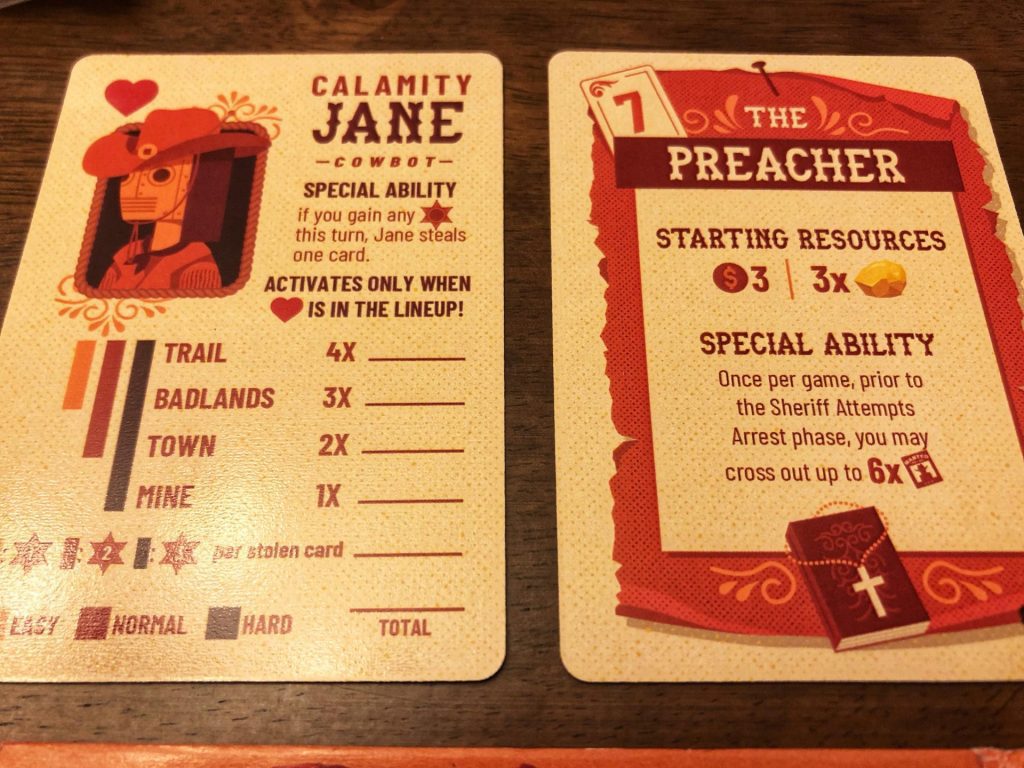
I’m All In
If you’ve played a few random-and-writes, Fliptown will feel very comfortable for you. It’s not quite as complicated as Three Sisters or Hadrian’s Wall, but the overall experience is very similar. Skilled players can create incredibly satisfying powerhouse turns. At the same time, there’s so many different permutations of possibilities that large chunks of the board end up empty despite your best efforts. It takes lots of practice to figure out how best to play the hand you’re dealt.
Practice is easy to accrue because this game plays fairly quickly, roughly 20-30 minutes per game once you’ve learned all the available options. And in my experience every game has played out differently, with no one strategy or area of the board consistently dominant. Even without the bots and characters, there’s a lot of game here. With them, you could easily play Fliptown dozens of times without it feeling stagnant.

While the preview copy I received only included solo play, the production copy is expected to provide materials for multiplayer. As with many random-and-writes, multiplayer will use a shared central deck with each player making their own choices based on the cards available each turn. Whether that appeals to you will largely depend on how much you enjoy the solo play.
My only real qualm with Fliptown is with the poker hand built each round. Good hands are rare in poker, and Fliptown doesn’t include any of the tools a skilled poker player might use to salvage a mediocre hand. There’s no bluffing, no check-raising, no betting on the button. As a thematic element, it’s clever enough; as a gameplay mechanic, it’s something best ignored as chasing a hand rarely pays off. From what I understand, Aramini is working on a way to improve this aspect of the game before release.
Aside from that small caveat, I love Fliptown. It’s an exceptionally well-made game with a fun theme. The art from Naomi Ferrall is sparse but fantastic, capturing the sun-baked sepia tones of classic Western tales. While it might not win a shootout against heavy hitters like Hadrian’s Wall, Fliptown is a great choice for random-and-write greenhorns or anyone looking for a quick-playing game in this genre. More than that, it’s a great publishing debut from a designer who’s looking to settle new ground.


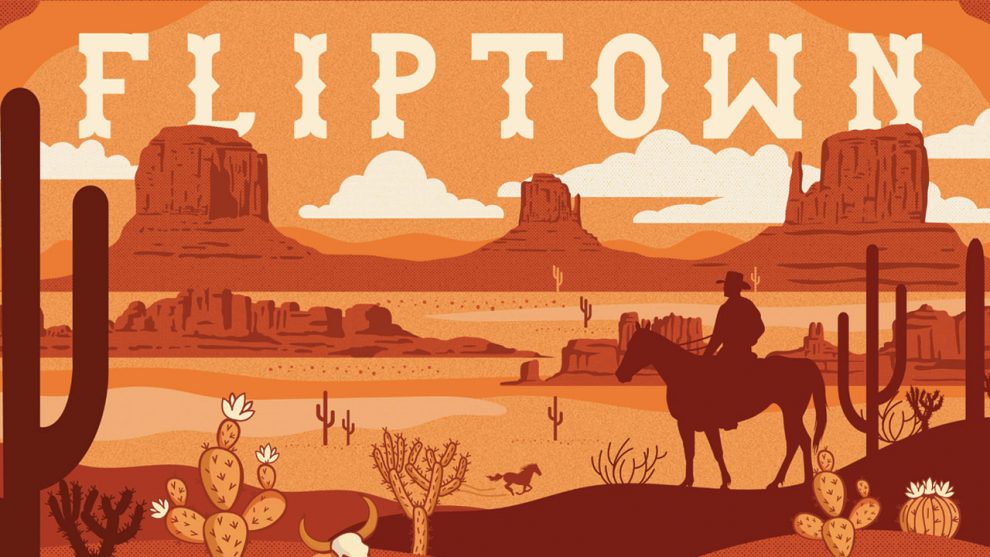

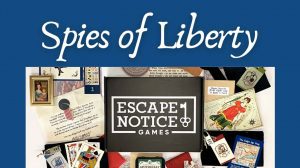

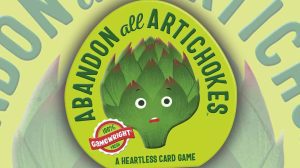





Thanks for the review, Ian. The final production copy will, of course, feature much better dry erase boards/pens so that your board will wipe clean every time. Glad you enjoyed the game!